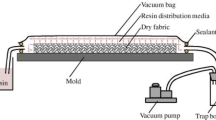Abstract
The importance of Si2N2O nanoparticle and tamarind fiber integration into a liquid diglycidyl-ether of bisphenol-A (LY556) based epoxy resin composite was investigated in this research. The primary objective of this study was to evaluate the mechanical, dielectrical and thermal properties of Si2N2O nanoparticle dispersed tamarind fiber-reinforced epoxy composite. The bio-composite laminates were prepared using hand lay-up method and examined in accordance with ASTM standards. The incorporation of Si2N2O nanoparticles enhances the tensile strength, flexural strength, and Izod impact strength, which seem to be 132 MPa, 172 MPa, and 5.74 J for composite designation 'N3', respectively. However, the 'N4' composite has the maximum hardness value of up to 92 Shore-D. In comparison to all other composite designations, ‘N4’ exhibits the highest dielectric loss and constant values of 0.94 and 6.2, respectively, as well as the highest reported Tg values of 550 °C. These mechanically strong, dielectrically and thermally stable composites could be utilised in a variety of industrial sectors, automotive parts, sports, and household applications.
Similar content being viewed by others
Data Availability
No data available to deposit as private.
References
Prakash VA, Viswanthan R (2019) Fabrication and characterization of echinoidea spike particles and kenaf natural fibre-reinforced Azadirachta-Indica blended epoxy multi-hybrid bio composite. Composites part A: applied science and manufacturing, 118, pp.317–326
Alshahrani H, Prakash VA (2023) Development of highly flexible electromagnetic interference shielding composites for electronic applications using Cobalt/Hevea brasiliensis seed husk carbon dots/Bamboo microfibre-polyvinyl alcohol. Industrial Crops and Products, 191, p. 115967
Amin, Muhammad Nasir et al. (2022) Materials (Basel, Switzerland) vol. 15,10 3431. 10 May. 2022, https://doi.org/10.3390/ma15103431
Alshahrani H, Prakash VA (2022) Mechanical, fatigue and DMA behaviour of high content cellulosic corn husk fibre and orange peel biochar epoxy biocomposite: a greener material for cleaner production. J Clean Prod 374:133931
Alshahrani, Hassan, VR Arun Prakash (2022) Progress in organic coatings 172 : 107080
Joshua O et al. Composite Interfaces, 28:9, 925–960, https://doi.org/10.1080/09276440.2020.1826274
Maheswari et al (2013) Int J Polym Anal Charact 18:520–533. https://doi.org/10.1080/1023666X.2013.816073
Chimsah et al. Academic Journals (2020) 14–9.http://hdl.handle.net/123456789/3006
Baig et al (2021) Materials Today: Proceedings 45:257–263. https://doi.org/10.1016/j.matpr.2020.10.433
Wu Shoujun et al (2013) Int J Refract Metals Hard Mater 36:97–100. https://doi.org/10.1016/j.ijrmhm.2012.07.007
Wang Yingxia et al (2020) Ceram J Int 467:8725–8729. https://doi.org/10.1016/j.ceramint.2019.12.111
** **ng et al (2020) J Hazard Mater 400:123145. https://doi.org/10.1016/j.jhazmat.2020.123145
Parrillo ety al (2021) SN Appl Sci 3:268. https://doi.org/10.1007/s42452-021-04307-y
Merneedi, Anjibabu, et al, (2021) Experimental investigation on mechanical properties of carbon nanotube-reinforced epoxy composites for automobile application." J Nanomater 2021
Merizgui T et al (2019) Mater Res Express 6(4):046102. https://doi.org/10.1088/2053-1591/aaf9de
Arun Prakash VR et al (2019) Mater Res Express 6:076113. https://doi.org/10.1088/2053-1591/ab1694
Arun et al (2019). Silicon. https://doi.org/10.1007/s12633-019-00347-7
Natrayan L, Merneedi A, Bharathiraja G, Kaliappan S, Veeman D, Murugan P (2021) Processing and characterization of carbon nanofibre composites for automotive applications. J Nanomater 2021:1–7
Vincent et al (2022) Biomass Conv Bioref 12:4009–4019. https://doi.org/10.1007/s13399-020-00831-w
Mahadevaswamy et al. (2019) Materials Today: Proceedings, S2214785319332006–.https://doi.org/10.1016/j.matpr.2019.08.211
Ramaswamy R, Gurupranes SV, Kaliappan S, Natrayan L, Patil PP (2022) Characterization of prickly pear short fiber and red onion peel biocarbon nanosheets toughened epoxy composites. Polym Compos 43(8):4899–4908
Senthil Kumar S et al (2022) Mechanical, fracture toughness, and fatigue behavior of spinifex littoreus fiber on echinoidea-spike toughened epoxy composite.". Polym Compos 43(4):2329–2340
Merizgui T et al (2018). Mater Res Express. https://doi.org/10.1088/2053-1591/11f9de
G. Devi, N Nagabhooshanam, M Chokkalingam, SK Sahu (2022) Polym Compos, 1. https://doi.org/10.1002/pc.26898
Samuel B et al (2021) Silicon 13:1703–1712. https://doi.org/10.1007/s12633-020-00569-0
Subbiah Ram et al (2022) Effect of nanosilica on mechanical, thermal, fatigue, and antimicrobial properties of cardanol oil/sisal fiber reinforced epoxy composite.". Polym Compos 43(11):7940–7951
Thiyagu et al (2021). Biomass Conversion and Biorefnery. https://doi.org/10.1007/s13399-021-01941-9
Arun Prakash VR et al (2016) Appl Surf Sci 384(16):99–106. https://doi.org/10.1016/j.apsusc.2016.04.185
Alshahrani Hassan et al (2022) Effect of palmyra sprout fiber and biosilica on mechanical, wear, thermal and hydrophobic behavior of epoxy resin composite.". J Indust Text 52:15280837221137382
Alshahrani Hassan et al (2022) Mechanical properties study on sandwich composites of glass fiber reinforced plastics (GFRP) using liquid thermoplastic resin, Elium®: preliminary experiments.". Coatings 12(10):1423
Funding
No funding received for this research work.
Author information
Authors and Affiliations
Contributions
Suganya G-Research work and drafting.
Manoj Kumar S-Research work.
Nagaraj M-Testing.
Velumani-Testing.
Corresponding author
Ethics declarations
Yes.
Ethics approval
Not applicable.
Consent to participate
NA
Consent for publication
Yes. All permission granted.
Compliance with ethical standards
Yes.
Competing interests
Nil.
Conflicts of interest
Nil.
Additional information
Publisher's Note
Springer Nature remains neutral with regard to jurisdictional claims in published maps and institutional affiliations.
Rights and permissions
Springer Nature or its licensor (e.g. a society or other partner) holds exclusive rights to this article under a publishing agreement with the author(s) or other rightsholder(s); author self-archiving of the accepted manuscript version of this article is solely governed by the terms of such publishing agreement and applicable law.
About this article
Cite this article
Suganya, G., Kumar, S.M., Nagaraj, M. et al. Mechanical, Dielectric and Thermal Stability of Silicon Oxynitride Nanoparticle Dispersed Tamarind Fiber-Reinforced Epoxy Bio-composite. Silicon 15, 4019–4025 (2023). https://doi.org/10.1007/s12633-023-02320-x
Received:
Accepted:
Published:
Issue Date:
DOI: https://doi.org/10.1007/s12633-023-02320-x



